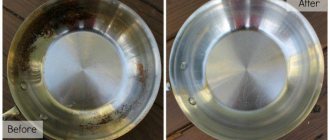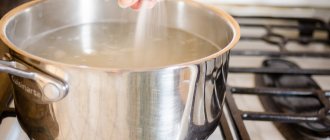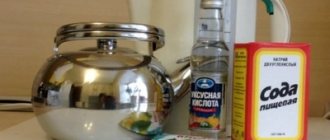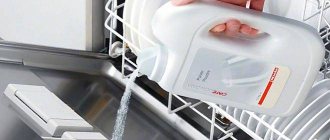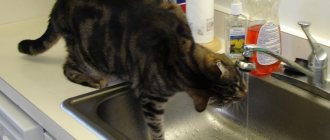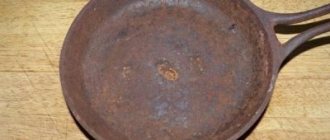Some housewives have stainless steel sinks installed in their kitchens, the popularity of which is growing every day. Kitchen utensils made from this material are in perfect harmony with other appliances and, with proper care, retain their original appearance. They are also considered more aesthetic, hygienic and practical.
But no matter how durable the sink is, stains, plaque and rust can form on it. And therefore, you need to identify the reasons that affect the appearance of the sink and find out with what means and methods you can remove dirt, while avoiding the formation of defects.
How to remove plaque from a stainless steel sink
Many people think that stainless steel kitchen utensils can be cleaned in a matter of minutes if you use chemicals. Of course, household chemicals can save housewives from unnecessary work, but you need to understand that contact with oxidizing particles will cause plaque on the sink.
Therefore, it is better to first try to get rid of contaminants using natural remedies, most of which can be found in every home.
- Lemon acid. Fill the sink with warm water, add a small packet of citric acid and leave for 1.5-2 hours. After the time has passed, wipe the areas with a soft sponge, let the liquid drain out and rinse the sink. You need to be careful with citric acid, as dark spots will appear due to the highly concentrated solution.
- Oxalic acid. Dilute the acid with water, apply the resulting mixture to problem areas and wash off everything after half an hour.
- Dry mustard. Pour the component into the sink, wipe with a sponge, and wash thoroughly. Thanks to mustard, you can get rid of not only plaque, but also unpleasant odors.
- Oven cleaning paste. Apply the substance to the problem area, treat with a sponge, rinse and wipe.
Folk substances are safer because they do not contain harmful particles. They especially help housewives who have small children. Simple remedies will help keep your sink clean and keep your family safe.
Cleaning a faience sink
Daily cleaning of a faience sink does not require special cleaning products. It is enough just to wipe the surface with soapy water. Like enamel sinks, such sinks are resistant to hard metal brushes and abrasive powders, so soft rags and foam sponges should be used for them. Simple stains can be removed with soda, and lemon will help to add freshness and prevent germs. It is enough to rinse the sink after cleaning with water and squeezed lemon juice.
You can restore the whiteness of a faience sink that has darkened over time using bleach. It is necessary to draw water inside, having previously plugged the drain hole, and add a little bleach. After half an hour or more, drain the solution and rinse the surface thoroughly.
Every housewife should know how to clean the sink and make the kitchen environment ideal. There is no need to purchase expensive chemicals for cleaning; many effective products are available in every home. All you have to do is follow the tips and choose the most appropriate cleaning method for yourself.
Methods for everyday cleaning of your sink
It doesn’t matter what material the kitchen sink is made of, because it always needs to be looked after in order to avoid serious problems in the future. For housewives, this process is automatic; they simply empty the sink of plates and food waste, wipe the surface with a rag soaked in a household product, rinse with water, and then wipe with a kitchen napkin.
However, you need to understand that the procedure should be performed more responsibly. If limescale has just begun to appear on the walls of the sink, on the faucet and on the drain, you need to treat the areas with the hard side of the sponge. Then the surface should be wiped thoroughly so that not a single drop of water remains.
It is because of the hardness of the water that first rainbow spots appear on a stainless steel sink, and then a coating, so these tips should not be neglected.
Unpleasant smell
A clean sink is only half the battle. Its shine will not please you if it emits unpleasant “odors.” Particles of food remain in the pipe, they begin to decompose - hence the smell. It is very persistent, but you can get rid of it in two proven ways:
- Vinegar + soda. 100 g of soda is poured into the drain and the same amount of table vinegar is poured. After this, a hiss will be heard and foam will begin to emerge from the pipe - this indicates the beginning of cleansing. After ten minutes, boiling water is poured into the drain, which should remove the accumulated dirt.
- Mole. This tool has been in demand for many decades, because it copes with the task. You just need to pour the required amount of the composition into the drain and fill it with water according to the instructions.
Preventative measures
To avoid problems and make the cleaning process easier, you need to remember about prevention.
- Do not use products that contain abrasive particles. Powdery substances will cause small scratches on the sink where dirt and bacteria will accumulate.
- Do not leave food waste on the sink. As soon as you wash the dishes, immediately clean the drain of any remaining food, otherwise new stains will form and eat into the surface.
- Do not use metal brushes. These devices cause defects.
- Polish regularly. The sink should maintain a shiny appearance, so it needs to be treated with vegetable or olive oil 2 times a month.
- Do not leave dirty dishes in the sink for a long time. Because of them, an unpleasant odor, plaque, and rust will appear.
Thanks to the above steps, you can keep your kitchen sink looking flawless and avoid serious problems.
Cleaning an enamel sink
The enameled surface does not tolerate hard metal brushes and abrasives; they can leave scratches on it in which dirt will accumulate. To clean such a sink, it is better to use sponges and rags, as well as nylon bristles.
Rust stains often remain on enamel surfaces. To get rid of them, you can purchase a special product at a hardware store or prepare it yourself. You need to pour 100 grams of ammonia into a glass jar, and add 50 grams of peroxide to it. The process must be done very carefully; be sure to wear rubber gloves and protect your eyes.
The resulting solution must be mixed by shaking the lid of the jar. A clean rag should be soaked in the prepared product and applied to areas with rust, leaving for ten minutes. After this, rinse everything off with water.
Removing stains
You can remove stains using common substances that are found in almost every home. To get rid of plaque on a stainless steel sink, experienced housewives first of all recommend using hydrogen peroxide, which will not only clean, but also disinfect. In addition, the component is safer than chlorine bleach, which contains ions that are dangerous to stainless steel.
To properly carry out the cleaning process and get rid of contaminants, you must follow the following procedure:
- mix wine vinegar with hydrogen peroxide in a 3:1 ratio;
- moisten the sponge with the solution;
- wipe problem areas;
- leave for 15-20 minutes;
- rinse with water;
- wipe dry.
Scrubbers made of copper are used to remove stuck food and grease. And if you want to get rid of hard plaque, you can use a piece of lemon. To remove stains and rust, the sink is treated with soda solution or oil.
Removing dirt and greasy deposits
To remove greasy deposits, use regular dishwashing detergent. Laundry soap will do.
A cleaning agent made from soda and office glue will help clean the sink. How to clean a stainless steel sink:
- Boil 5 liters of water, add 100 g. soda and 100 ml of transparent stationery glue.
- Wait for dissolution. Close the sink and pour the prepared solution into it.
- When the mixture has cooled down, drain it.
- All dirt will come off. All you have to do is wash the sink with clean water.
This method is used to clean stainless cookware. It is boiled for 20 minutes, left to cool and rinsed with water.
Removing stains from the sink
Even if housewives regularly clean the sink, the procedure does not guarantee a 100 percent result. After all, due to various oxidizing agents, rust will appear on the surface. For proper care, you need to know what products help get rid of certain problems.
4 products to remove dark plaque
Darkened stains may form on the surface of the sink, and in this case the housewife usually uses strong chemicals. But household chemicals can be harmful to health, so it’s better to use improvised means:
- Soda. You need to pour the component onto a hard cloth, wet it with water and wipe the dirty areas. Then rinse and wipe with a soft cloth. To get rid of hard-to-reach stains, just use an old toothbrush.
- Vinegar. If you notice that dark spots have formed on the sink, then you need to moisten a rag with vinegar, wipe the problem areas, wait 25 minutes and rinse.
- Starch. The ingredient helps housewives get rid of rust. You need to close the sink drain, pour in a solution of water and potato starch, wait 40-50 minutes and let in the water.
- Regular bleach. In extreme cases, simple bleach can help remove dark stains. Just rub the problem area with this component and then rinse with water.
Removing heavy soiling
To get rid of grease stains, rust and limescale, you need to stock up on the following equipment: detergent, baking soda, vinegar, salt, sponge/rag, old toothbrush.
So, first you need to close the sink drain, fill the sink with hot water, add detergent (if you don’t want to use household chemicals, you can make a soap solution or buy ready-made liquid soap) and wait until the liquid cools down. When the water is warm, clean the dirty areas of the sink with a toothbrush and baking soda. Next, you need to rub it with vinegar, open the drain and rinse the sink with water.
Vinegar will give your sink a shiny appearance. This component also disinfects the sink and destroys bacteria.
If there are small stains on the sink, they can be treated with a vinegar-salt mixture, left for 25-35 minutes and rinsed.
Getting rid of unpleasant odor
Having cleaned the sink to an impeccable shine, housewives are surprised that a bad smell emanates from it. The cause may be pipes clogged with food debris. But there is a solution to this problem if you use two effective methods.
The first method is used using homemade products - soda and vinegar. You just need to pour 150 g of soda into the drain, pour in the same amount of vinegar, and as soon as the hissing and abundant foam starts, pour boiled water into the hole. This method will 100% help get rid of bad smell and blockage.
The second method is using the “Mole” cleaning product. Following the instructions, you need to pour the required amount of the component into the drain, fill everything with water, and then rinse.
Anti-blackness remedies
Blackness on stainless steel appears after 2 years. Even with proper care, the surface of the sink darkens and the shine disappears.
To care for the sink, use homemade compounds or household chemicals. You can use several products in combination to get the best effect.
How to clean a sink:
- Vinegar is an excellent cleaning agent. The universal composition saves from blackness, disinfects and whitens well. Directions for use: place a spray bottle on the bottle, spray over the surface, leave for 10 minutes. Rinse with water. Open the windows and ventilate the room.
- Starch and soda are used according to the same principle. A kitchen sponge is moistened with water and starch or soda is added. The oxidized area is cleaned with the hard side. All that remains is to wash the sink to remove any remaining product.
- Bleach works well to remove black stains on a stainless sink, but can leave white marks. Dilute with water, treat the sink, rinse with water. Clean carefully, making sure that the treated areas do not become lighter than the rest of the structure.
- Rub the problem areas with tooth powder.
Blackness is an oxidation process formed due to the negative effects of oxidizing agents. The sooner you start removing dark spots, the better they will come out.
Unfortunately, it is impossible to prevent their occurrence. It remains to use special means from time to time.
Types of sinks by installation method
In the kitchen you can find different types of sinks. They are usually divided according to the method of equipment and there are three varieties that have certain characteristics.
- Overhead sinks are “slipped” onto a floor cabinet. This type serves not only as a sink, but also as a countertop. Housewives do not have to worry about sizes, since manufacturers make small, medium and large sinks. To install a sink, you don’t have to call a professional, because the overhead type is very easy to install with your own hands. But it is worth noting that this type has one drawback - subtlety. Because of this negative point, the countertop sink may be subject to various defects and will last less than other types.
- The built-in sink is easily installed on the countertop. This type is becoming more popular every day. When installing the sink, no seams or cracks will form, which automatically prevents liquid accumulation.
- The integrated sink has a different structure of sides, i.e. 2 or 3 sinks are connected into a common façade. But this type is difficult to install yourself, so it is better to call a specialist. It will also require a special mixer that can easily make various turns. This type of sink should be installed just below the level of the countertop.
Daily care
If you use a sink to wash dishes (rather than a dishwasher, for example), remove food debris from the bottom after each use, and then wash the sink with the same dishwashing liquid. Rinse and be sure to dry. Droplets of water dry out over time, but leave behind white spots that spoil the appearance and lead to the formation of limescale. If you want the sink to shine, wipe it.
It is useful to carry out a similar procedure after each use of the sink. Even if you just washed the vegetables, wring out the cloth and wipe the inside surface from drops of moisture.
Types of pollution
Before you start cleaning sinks, you need to understand the nature of the problem, since there are different types of dirt, so they need to be cleaned using different methods.
How to remove limescale
The composition of the water contains a large amount of magnesium and calcium salts, due to which lime settles on the sink. To get rid of plaque, while maintaining the material in its original form, you need to use methods that are divided into two groups.
Chemicals. In household chemical stores you can find cleaning products that can quickly and efficiently deal with limescale. The most popular of them: BAGI acrylan, Comet gel, Cillit Bang.
But before you buy this or that product, you need to read the instructions in order to avoid problems in a timely manner.
Folk remedies. If you do not want to use household chemicals, then a stainless steel sink can be cleaned using available products. The most popular of them:
- salt;
- ammonia;
- hydrogen peroxide;
- lemon acid.
If you want to clean the sink from whitish spots and give it an impeccable shine, then moisten the sponge with 9% table vinegar, treat the problem areas and rinse the sink after 25 minutes.
How to remove rust
Rust is a little more difficult to clean, so for best results you can use one of the following methods.
- Hydrogen chloride. The substance helps get rid of old rust. You just need to wet a rag, apply it to the problem area for 15 minutes, and then rinse with water.
- Baking soda. The component helps get rid of a thin layer of rust. Sprinkle baking soda on the stains, after 2 minutes spray with table vinegar, and as soon as the hissing stops, go over with a cloth and rinse.
- Ammonia and hydrogen peroxide. By making a solution of these two components (proportions 2:1), you can give your plumbing fixtures a shiny look. The contaminated areas are treated with the prepared mixture and washed off with water after 15-20 minutes.
How to clear yellowness
As soon as you see a yellow coating on the plumbing, remove it immediately, otherwise rust will form. You can get rid of this problem using citric acid. Pour the substance onto problem areas, wait 5-10 minutes, treat with table vinegar, wipe with a rag and rinse. If you can’t immediately achieve a positive result, you can try again.
Interesting! The vinegar method helps get rid of not only yellow stains, but also stuck food debris.
How to remove dark spots
Dark spots look unpleasant and can be harmful to health, so you need to get rid of them in a timely manner. For an effective result, mix 100 ml of ammonia and the same amount of water, treat the dark areas with the resulting mixture, after 6-7 hours, go over with a cloth and wash the sink with a cleaning agent.
Important! Regardless of the types of contamination and cleaning methods, every housewife should take care of her health. Therefore, before cleaning the sink, you need to put on special gloves on your hands and a mask on your face. They will help keep your hands free from allergies and avoid poisoning.
All of the above methods help to quickly and efficiently clean a stainless steel sink without much effort or wasting time.
Household chemicals
The use of special products allows you to quickly clean a stainless steel sink in the kitchen, polish it and restore the protective layer.
- HG polish for stainless steel - recommended for the care of sinks, dishes and household appliances. Pros: leaves no streaks, removes dirt and grease, eliminates tarnish. Cons: high price. The creamy composition is applied to a damp cloth, then the contaminated area is wiped. Wash off with water and wipe the surface with a dry cloth.
- Steel Polish Grass is a liquid designed for surfaces that require delicate care. Perfectly restores the shine of stainless steel. Pros: erases dirt, fingerprints, shine, low cost. Minus: does not cope well with limescale. Shake the bottle before use and spray the product onto the sink. For polishing, use a soft, lint-free cloth.
- Dr. Beckmann - foam for cleaning metal surfaces removes traces of oxidation, grease, soap and limescale deposits. Pros: effectiveness, pleasant smell, safe polishing. Cons: small volume. Apply the foam to the damp surface of the sink, rinse with a sponge after 2-5 minutes.
Home remedies for cleaning stainless steel cutlery
Using home remedies, you can clean not only the sink, but also tableware.
- The easiest way to clean stainless steel items is dish gel. The component is squeezed onto a sponge, the devices are thoroughly wiped, then rinsed under water and wiped with a dry cloth to prevent white streaks from appearing.
- A simple way is boiling. You need to put the equipment in a large container, fill it with boiled water and put it on medium flame. After boiling for 25-55 minutes, the devices should be washed in warm water and wiped.
- Toothpaste. Apply the component to a sponge, process the products, rinse in warm water and wipe.
- A solution of water and mustard. Mix mustard powder in warm water to form a paste, wipe the devices and wash them.
- Brewing residue can be removed with vinegar. Pour some vinegar into a rag, wipe the items and rinse them. If you want to get rid of stubborn stains, place kitchen items in a large container, pour in a little vinegar and water, leave for 25-30 minutes, and then wash.
- In extreme cases, ash can be used to clean appliances. The component is moistened in warm water, applied to a sponge, wiped the kitchen utensils, then placed the items in a container with warm water, left for 5-10 minutes, cleaned with a regular product and wiped dry.
Important! Stainless steel products cleaned using home remedies should be stored in kitchen compartments, away from dust, water and other sources of contamination.
Every housewife likes to look at a shiny sink, and therefore you need to listen to advice and properly care for it. By daily cleaning to remove food debris and moisture, you can achieve an attractive glow and impeccable cleanliness.
Traditional methods
All recipes are very simple. They are based on the properties of natural substances that are found in every kitchen.
Boiling
The recipe was invented by housewives during Soviet times. At that time, there were practically no household chemicals in stores. Everyone used improvised means.
Inside
The cleaning solution is poured into a stainless steel container. Place it on the burner, heat the liquid to a boil, and simmer over low heat for at least 2 hours. Leave to cool. The solution is drained. Rinse the pan and wipe dry.
Outside
Take a large enamel basin or tank. Fill it with cleaning solution. Place it on the stove. Stainless steel objects are lowered into it. The liquid should completely cover them. The dishes are boiled for at least 2 hours. Remove from the pan when the solution has cooled. All items are washed under running water and wiped.
How to prepare the composition
Take the required volume of water. The working solution is prepared based on the following proportions:
- water - 5 l;
- stationery glue - 100 ml;
- soda - 500 g.
Anti-carbon pastes
There is always a product in the kitchen that can be used to scrub off burnt milk and porridge.
Ground activated carbon
Remains of burnt porridge are quickly removed with activated carbon. The tablets are crushed. Powder is poured onto the bottom of the pan. Pour water into it. After 15 minutes, the carbon deposits are easily wiped off.
Ground coffee beans
Thrifty housewives do not throw away filters with spent coffee. They use grounds instead of body scrub and metal pan cleaner. Apply it to the contaminated area, rub with a sponge, leave for 10 minutes, and rinse with water.
Liquids from white deposits and scale
Scale forms in the kettle, and a white coating forms on the walls of the pan. The cause of deposits is hard water. There are 3 products that can easily cope with this type of pollution.
Citric acid solution
Fill the kettle ⅔ full with water. Add 20 g of citric acid. Boil. Allow the water to cool and boil one more time. Plaque removal begins after a few hours. Scrub with a sponge or brush.
Coca Cola
Fill ⅔ of the pan with the drink. Bring it to a boil. Leave to cool. The plaque is wiped off after 30 minutes. Use a brush or sponge.
How to treat cutlery
Spoons, forks and knives lose their shine over time and contact with food. Restore your radiance using affordable products.
9% vinegar and lemon juice are equally effective. They are applied to cutlery with a flannel napkin. After 30 minutes, rinse and wipe dry.
Ammonia
The lost shine is restored with ammonia. It is added to water - 1 tsp. l/l. The previously washed stainless steel cutlery is lowered into the basin. After 5-10 minutes, rinse spoons, forks, and knives and wipe dry with a kitchen towel.
Non-abrasive toothpaste or powder
The products remove the yellow film and polish the surface. A small amount of paste is applied to the surface and rubbed with a napkin. After rinsing, wipe and rub until shiny with a towel.
Mustard powder
Mustard powder has cleaning properties. It is used to make paste. Stirring constantly, add warm water. The mixture is applied with a brush to the tarnished surface of the stainless steel.
Wear gloves when working with table vinegar. It quickly removes all types of contaminants. Apply it to a soft sponge and wipe tarnished metal surfaces. Durable films of old fat are difficult to remove. To enhance the cleaning effect, add lemon juice to the vinegar. After the procedure, the dishes are rinsed.
Lemon juice solution
Squeeze the juice from half a lemon. For 1 liter of water you need only 1 tbsp. l. Moisten a sponge with the resulting solution and wipe the pan with it inside and out. Rinse it with water and wipe dry with a towel.
Steel Polish
No need to run to the store. An effective polish is available in the kitchen.
Raw potatoes
To make the kettle shine like new, wash the potatoes and cut them into 2 halves. Rub them on a steel surface. Use the same method to shine the pots.
How to get rid of burnt jam
Burnt sugar is difficult to remove. The work is simplified by using table vinegar and laundry soap for cleaning. Water is poured into the pan. Pour in soap shavings. Bring to a boil. Remove the pan from the burner. Pour in ½ tbsp. vinegar. When the water has cooled, wipe off the dirt.
How to remove rust
Small rusty areas are removed with baking soda. The surface is moistened with a sponge. Powder is applied to her. After 60 minutes, try to scrub off the rust with a brush. If the result is achieved, the surface is washed with clean water and wiped.
With regular care, stainless steel cookware will not tarnish. Serves for many years, maintaining an attractive appearance and functionality.
Why choose stainless steel?
How to choose the right sink? In today's market, sinks made of material that does not rust are relevant.
The main advantages when choosing such a stainless steel kitchen item are:
- Low price.
- The service life is quite long.
- Durable, withstands heavy loads.
- Resistant to high temperatures.
- It does not contain harmful metals.
To ensure that your sink always looks like new, you need to keep it clean. Don’t forget to remove all kinds of dirt from it. Every housewife should remember that cleaning the dish sink should be done regularly. Daily contact with water affects the condition of the coating.
Cleaning: what is special?
A stainless steel sink is very aesthetically pleasing and beautiful to look at, but is difficult to maintain. This is the most versatile and frequently used type of kitchen equipment. Easily fits into any interior. However, despite all the inherent advantages of a bowl-shaped device, there are also several disadvantages in using stainless steel sinks:
- small scratches, marks and stains on its surface are always noticeable;
- poor sound insulation;
- predisposition to oxidation;
- various negative reactions to cleaning products.
To keep your sink in good condition, you need to take care of it and do general cleaning at least once a week. This will not only give the kitchen an aesthetic appearance, but will also protect the whole family from various diseases.
Major cleaning of heavy soiling
If you neglect daily preventative care, your sink can become very dirty and look completely unsightly. Grease deposits, lime deposits, darkened surfaces, black spots, ingrained dirt in grooved areas, unpleasant odors and clogged drains - everything looks as if it is easier to buy a new sink than to clean up the old one. However, even in such a sad situation, it is possible to cope with the problem.
- First of all, we soften the most significant dirt. Why fill it with hot water to the brim, pour in dishwashing liquid, stir and leave to soak. Or we use dishwasher cleaner - throw a portion into the sink with boiling water, stir and leave for a few minutes.
- We drain the water, and thoroughly clean off the softened dirt with the hard side of a foam sponge and rinse with warm water.
- We remove dirt from hard-to-reach and grooved areas: mechanically clean them with an old toothbrush, after sprinkling with soda.
- Make a mixture of baking soda and fine table salt in a 1:1 ratio, add a little hot water until you get a liquid slurry, stir until the salt grains completely dissolved. It is important that there are no solid particles of salt left - if necessary, add a little boiling water and mix thoroughly until all the salt has dissolved. We saturate the sponge with the resulting mixture and carefully rub the entire inner surface of the sink. Leave for a few minutes, then rinse with water.
- Let's take care of the drain hole. You can use special products like “Mole” or resort to a simple and cheap way to clean drain pipes: pour a glass of soda ash into the drain. Then pour a glass of 9% vinegar. A strong chemical reaction will begin, as a result of which the contaminants inside will soften, begin to peel off and dissolve. After five minutes (no longer!) pour boiling water into the kettle. Then rinse thoroughly with hot water, for which you can fill and flush the sink full several times. If necessary, the entire procedure can be repeated.
- Now, if the need remains, you can do a more thorough cleaning of hard-to-reach and grooved areas using soda or special chemicals (necessarily suitable for stainless steel), removing the remaining dirt and limestone from the old toothbrush.
- We bring the final shine. Rub a clean stainless sink with starch or toothpaste without abrasive particles. This will brighten the surface and give it pristine purity.
